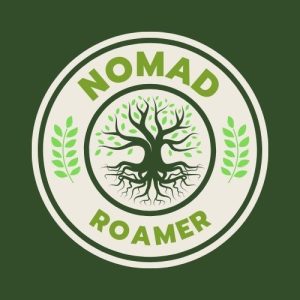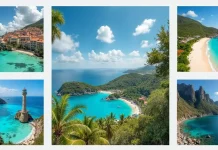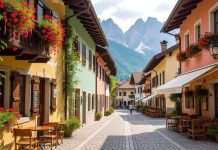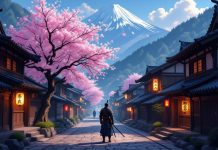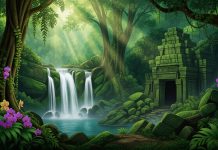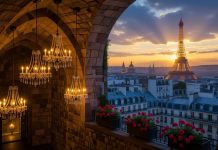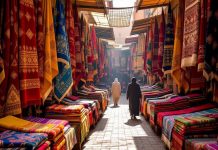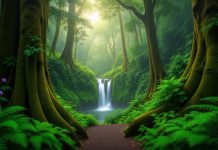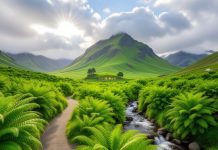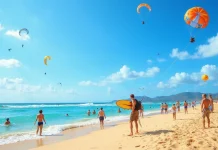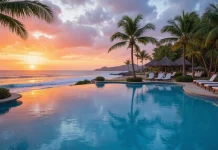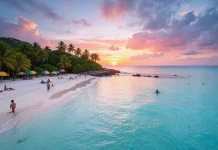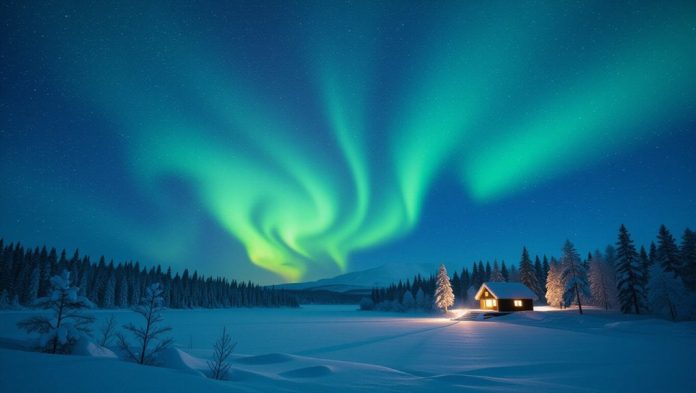If you’re chasing the enchanting Northern Lights in Canada, you’re in for a treat! Head to prime locations like Yellowknife, where dark skies reign and solar activity peaks from late September to early April. Dress warmly with layers to brave the cold, ensuring a comfortable experience while mesmerized by the colors dancing overhead. Investigate unique adventures like Indigenous tours and exhilarating dog sledding. There’s so much more to uncover about planning your ultimate aurora adventure!
Key Takeaways
- The best locations for viewing the Northern Lights in Canada include Yellowknife, Yukon, and Nunavut, particularly from late September to early April.
- Optimal viewing conditions occur during December to March, with longer nights and higher solar activity enhancing the experience.
- Dress warmly in layered clothing, including thermal base layers, down jackets, and insulated accessories to endure cold temperatures during outdoor viewing.
- Unique experiences like Indigenous tours, dog sledding, and private photography sessions provide memorable adventures alongside the stunning auroras.
- Use a DSLR or mirrorless camera with manual settings and a sturdy tripod for capturing breathtaking images of the Northern Lights.
Understanding the Northern Lights: Science and Myths
Have you ever pondered what generates the intriguing display of the Northern Lights? These enchanting phenomena, known as the Aurora Borealis, occur when charged particles from the sun collide with gases in Earth’s upper atmosphere, resulting in breathtaking colors like green, pink, violet, and red.
Discover the mesmerizing Aurora Borealis, where solar particles create vibrant colors in Earth’s atmosphere.
While many myths suggest you need freezing temperatures and deep winter darkness to see them, that's not true! Auroras can light up the skies anytime solar activity is high, especially in high-latitude regions.
To enhance your chances of witnessing these stunning displays, keep an eye on the KP index, which tracks visibility conditions and intensity. Clear skies are vital for a perfect view, so plan accordingly!
As we approach the 2025 solar maximum, the frequency and intensity of auroras may increase, offering even more opportunities to experience this natural wonder. Embrace the magic of the Northern Lights!
Best Locations for Aurora Viewing in Canada
Observing the Northern Lights is a breathtaking experience, and Canada provides some of the finest spots to see this celestial spectacle. One of the best locations is Yellowknife in the Northwest Territories, renowned for its prime viewing conditions. This area boasts clear dark skies, crucial for experiencing the awe-inspiring phenomenon.
The best months for aurora viewing typically range from late September to early April, with winter offering the highest chances. Seek out open fields or lakes, where urban light pollution is minimal, improving your chances of witnessing the lights' breathtaking reflections.
Local aurora forecasting websites are priceless tools, helping you pinpoint the nights with the best visibility. Other excellent locations include parts of Yukon and Nunavut, which also offer fantastic opportunities for an unforgettable aurora experience.
Don’t miss the chance to chase the Northern Lights in these extraordinary Canadian destinations!
Ideal Travel Seasons for Aurora Chasing

If you’re enthusiastic to chase the mesmerizing Aurora Borealis, timing your visit is vital.
Late September to early April is your best bet, especially between December and March when the nights are longest and skies are clearest.
Keep an eye on the moon phases and weather conditions to optimize your chances of witnessing this breathtaking natural display.
Best Months for Viewing
When planning your aurora pursuing adventure, the months between late September and early April provide the best opportunities for witnessing the Northern Lights in Canada.
Specifically, October, November, and December are prime months, featuring longer nights and heightened solar activity. If you're heading to the Northwest Territories, particularly Yellowknife, late December to early February offers ideal viewing conditions with the clearest skies.
March is also a great choice, as it combines longer daylight hours with excellent nighttime aurora sightings.
To enhance your chances of catching this breathtaking phenomenon, keep an eye on solar activity and local weather forecasts.
With the right timing, you'll create unforgettable memories under the mesmerizing dance of the Northern Lights.
Weather Considerations and Tips
While the thrill of chasing the Northern Lights can be exhilarating, understanding the weather conditions is crucial for maximizing your experience.
The best time to witness the Aurora typically spans from late September to early April, with peak visibility in the cold winter months of December to February.
To improve your adventure, keep these tips in mind:
-
Monitor the KP index for solar activity.
-
Seek locations in Yellowknife for minimal light pollution.
-
Prioritize clear skies for ideal viewing.
-
Dress warmly to endure cold temperatures.
-
Plan your trips around forecasts to avoid cloud cover.
With the right preparation, you can fully embrace the magic of the Northern Lights while enjoying the stunning beauty of Canada’s winter scenery.
Seasonal Activities and Events
After understanding the weather considerations for your Aurora adventure, it's time to discover the lively seasonal activities and events that make your trip unforgettable.
From late September to early April, you’ll find peak visibility for the Northern Lights, especially in Yellowknife, where clear skies improve your chances of witnessing this natural wonder.
Embrace the thrill of dog sledding across snowy terrains or try your hand at ice fishing in remote locations, both often included in aurora viewing packages.
With the solar activity cycles peaking in 2025, the displays promise to be even more spectacular.
Each activity not only deepens your connection to this enchanting environment but also guarantees your journey is as memorable as the breathtaking auroras above.
Planning Your Northern Lights Adventure

To guarantee you have the best chance of witnessing the mesmerizing Northern Lights, planning your adventure with careful consideration is crucial. Start by scheduling your trip during the peak viewing season from late September to early April. Focus on remote areas in the Northwest Territories and Northern Canada, where dark-sky locations improve your aurora viewing experience.
Here are some vital tips to keep in mind:
-
Book accommodations near dark-sky locations to avoid light pollution.
-
Employ aurora forecasting apps to track solar activity and weather conditions.
-
Consult local travel experts for personalized itineraries tailored to your interests.
-
Incorporate outdoor adventures into your plans for a memorable experience.
-
Remember to dress warmly in thermal layers for extended outdoor exposure.
With thoughtful planning and expert guidance, you're well on your way to an unforgettable Northern Lights adventure!
Dressing for Success: Essential Gear for Aurora Hunting
When you’re gearing up for an aurora hunting adventure, think layers to keep warm and comfortable.
Start with thermal base layers, add a down jacket, and don’t forget those windproof and waterproof outer layers for protection against the elements.
Accessories like toques, scarves, and mittens are crucial to guarantee you enjoy the magic of the Northern Lights without the chill.
Clothing Layering Strategies
As you gear up for an unforgettable night of aurora hunting, understanding the art of clothing layering is vital for staying warm and comfortable.
Start with thermal base layers to retain body heat, then add insulated mid-layers for extra warmth. A waterproof outer shell is critical for protecting against wind and moisture.
Your extremities are particularly vulnerable, so consider these necessities:
-
Down jacket or high-quality synthetic insulated jacket
-
Insulated boots
-
Toques and scarves
-
Mitts or gloves
-
Hand and foot warmers
Always check the weather conditions and be ready to adjust layers as necessary, since temperatures can fluctuate markedly throughout the night.
With the right clothing layering strategies, you’ll be fully equipped to enjoy the stunning auroras!
Essential Accessories Checklist
After ensuring you’ve layered up appropriately for warmth, it’s time to focus on the accessories that can enhance your aurora hunting experience.
Start with a good pair of waterproof gloves; they’re vital for handling your camera while keeping your hands warm. Don’t forget insulated boots to protect your feet from the cold ground.
Snow pants or insulated trousers will keep you comfortable whether you’re sitting or moving in snowy conditions. To shield your extremities, pack toques, scarves, and mitts.
Finally, a reliable headlamp or flashlight is important for traversing dark areas safely as you gaze at the stunning Northern Lights. These vital accessories will help you enjoy your adventure without the chill!
Unique Experiences and Activities During Your Trip

While you’re on your Northern Lights journey, you’ll uncover a wealth of distinctive experiences that truly distinguish this trip apart.
From immersive cultural encounters to exhilarating activities, each moment is designed to improve your adventure.
-
Enjoy intimate Aurora Chasing Adventures with small groups for a personalized experience.
-
Join an Indigenous Aurora Tour, where storytelling and traditional foods deepen your cultural understanding.
-
Experience adrenaline-pumping adventure sports like dog sledding and snowmobiling, often included in packages.
-
Opt for all-inclusive packages that cover meals, accommodations, and activities at select lodges, making your trip hassle-free.
-
Capture the mesmerizing lights with private Aurora photo sessions, guided by professionals to help you get that perfect shot.
These unique experiences not only create lasting memories but also connect you with the magic of the Northern Lights in ways you’ll never forget.
Customer Testimonials: Memorable Aurora Encounters
Witnessing the Northern Lights often leaves travelers with unforgettable memories that they'll cherish forever.
Customer testimonials reflect a breathtaking experience, with many describing their aurora adventure as a once-in-a-lifetime opportunity. Roger Marling from the USA marveled at the lively colors of the auroras and highlighted the joy of smooth trip planning.
Travelers rave about the knowledge of local guides, who expertly navigate to ideal viewing spots, even in challenging weather conditions.
Moreover, the tailored experiences, including Indigenous storytelling and cultural insights, enrich your journey, providing depth to the natural wonder above.
Positive feedback consistently emphasizes satisfaction with every detail, improving the overall experience for aurora chasers.
Whether you're captivated by the dancing lights or the stories that accompany them, the Northern Lights promise memories that last a lifetime.
Tour Operators and Accommodation Options

When planning your Northern Lights adventure, choosing the right tour operator and accommodation can improve your experience to greater levels.
Opt for specialized companies like Trail Blazer Tours or Great Slave Lake Tours, which offer tailored Aurora viewing packages. If you’re looking for an Indigenous-owned experience, My Backyard Tours provides unique adventures that connect you with local culture.
As for accommodation options, you can find a range of choices to suit your needs:
-
Brabant Lodge, featuring housekeeping services and float plane flights
-
Cozy cabins with direct views at Castaways Cottages
-
All-inclusive packages that cover meals and activities
-
Spacious lodges near Great Slave Lake for ideal viewing
-
Immersive experiences that make your stay unforgettable
With the right tour operator and comfortable accommodation, you’ll create lasting memories under the mesmerizing Northern Lights.
Tips for Capturing the Perfect Aurora Photograph
Capturing the Northern Lights in all their glory can be just as thrilling as experiencing them in person.
To get started, use a DSLR or mirrorless camera with manual settings. Set your ISO between 1600-3200, aperture at f/2.8-f/4, and a shutter speed of 5-15 seconds for stunning aurora photography. A sturdy tripod is crucial to prevent camera shake, and consider a remote shutter or intervalometer to minimize movement.
To guarantee sharp images, switch to manual focus and target a distant bright star, as autofocus may falter in low light. Keep spare batteries warm, since cold weather can drain them quickly.
Use lens hoods to reduce flare from the aurora, and don't forget about composition—incorporating trees or scenery adds depth to your shots.
With the right camera settings and a little creativity, you’ll capture breathtaking memories of this natural wonder!
Frequently Asked Questions
What Is the Best Month to See the Northern Lights in Canada?
The best month to see the Northern Lights in Canada is February.
During this time, you’ll experience ideal conditions for aurora viewing, especially in popular locations like Yellowknife.
Embrace guided tours that improve your chances of witnessing this magical phenomenon.
Keep an eye on weather patterns and consider local festivals for a richer experience.
Don't forget your camera—photography advice can help you capture the cultural significance of these stunning displays in winter's embrace.
What Does the Bible Say About the Northern Lights?
Ever gazed at the Northern Lights and wondered about their biblical significance?
While the Bible doesn’t mention auroras directly, it celebrates God’s creation through celestial phenomena. Verses like Psalm 19:1 highlight the divine artistry behind nature's wonders.
You can find light symbolism in Isaiah 30:26, reflecting the beauty of the heavens. This spiritual interpretation invites you to investigate the connection between faith and science, appreciating the magnificent fabric of God's creation.
Why Is 2025 a Good Year for the Northern Lights?
2025's a fantastic year for Northern Lights because heightened aurora activity corresponds with solar cycles, promising stunning displays.
Climate factors and reduced light pollution in ideal locations improve visibility, making your photography opportunities incredible.
You’ll find travel packages tailored for peak viewing, with historical sightings backing this trend.
Plus, the cultural significance of auroras enhances your experience.
Immerse yourself in scientific research to deepen your understanding and make this adventure unforgettable!
How to Plan the Ultimate Trip Around the Northern Lights?
To plan the ultimate trip around the Northern Lights, start by exploring the best viewing locations and consider guided tour options for expert insights.
Did you know that the auroras are best seen between September and March?
Pack warm clothing necessities like thermal layers and insulated boots, and don’t forget your camera for Northern Lights photography.
Use mobile apps to track aurora activity, and savor local cuisine experiences with ideal travel companions while ensuring safety outdoors.
Conclusion
In Canada’s enchanting cold, chasing the Northern Lights promises a mesmerizing mix of magic and memory. With the right planning, proper gear, and a sprinkle of spontaneity, you'll uncover the stunning spectacle that dances in the night sky. Embrace the delightful experience, investigate unique adventures, and witness the wondrous auroras that illuminate the icy scenery. So, grab your camera, bundle up, and set out on this breathtaking journey—your unforgettable aurora adventure awaits!
